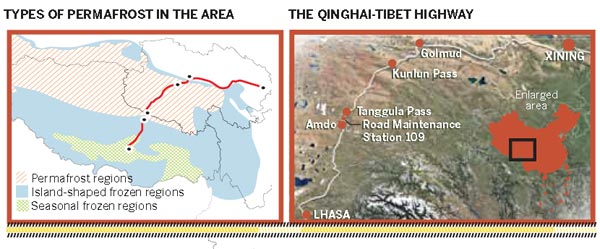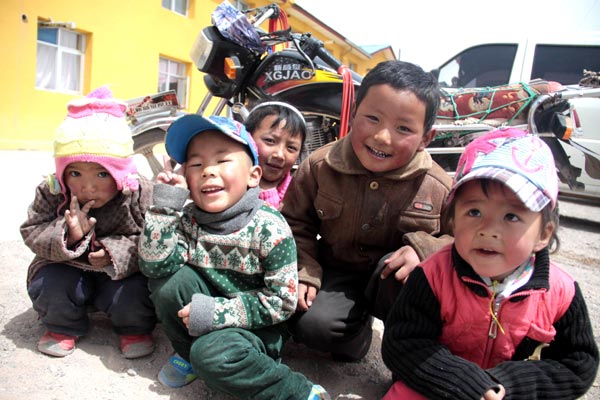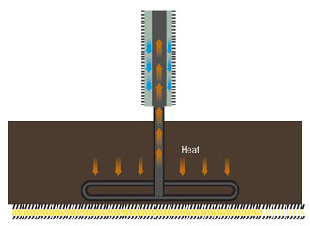Vital lifeline
By Hu Yongqi and Da Qiong (China Daily) Updated: 2014-05-28 08:08
|
 |
|
Workers from Road Maintenance Station 109 repair a section of the Qinghai-Tibet Highway in Amdo county. [Photo by Da Qiong / China Daily ] |
 |
|
Miserable nights and enthralling days in Amdo After spending just one night in Amdo county, the crushing headaches and breathlessness caused by the lack of oxygen will be imprinted in my memory until the day I die. |
The dim light emitted by a coal- and cow-dung-fueled oven helped to warm the small apartment where Tsering Degyi and her husband Gunga were cooking potatoes.
They were in for a long wait; at an altitude of more than 5,200 meters, cooking dinner is time-consuming, because water boils at a much lower temperature.
While the potatoes roasted slowly, the couple spoke in low voices, discussing the day's events in a Tibetan dialect.
Suddenly, the quiet of the room was shattered by a cellphone ringing. Tsering Degyi leaped quickly to her feet and strode to the window where the phone hung in an old cigarette packet pasted to the window frame, the optimum position for receiving mobile signals.
She picked up the phone and smiled as she heard her son's voice at the other end. The 38-year-old mother is always impatient as she awaits the daily call from her son, who lives 130 km away in the county seat of Amdo, Nagchu prefecture, in the north of the Tibet autonomous region.
Long periods of separation from their children are a fact of life for couples such as Tsering Degyi and Gunga and their fellow workers at Road Maintenance Station 109 on the Qinghai-Tibet Highway. The dearth of amenities in this mountainous region means almost everyone sends their children away to school.
With only the weakest of phone signals and few visitors, the maintenance station, which was established 30 years ago, has long been considered "isolated", even though more than 12,000 vehicles traverse the highway every day, and the number rises to 21,000 during the prime travel season, according to the Qinghai-Tibet Highway Management Bureau.
Between October and April, blizzards are frequent on the Qinghai-Tibet plateau, and many members of the road maintenance crew are plagued by frostbite as they work through the freezing winter months to keep the highway open. The workers said the stretch that runs from Golmud in Qinghai province to Lhasa, the capital of the Tibet autonomous region, is particularly tough.
Life is hard on the plateau, and the road crews battle loneliness and altitude sickness to ensure that the vital lifeline remains open, especially during the snowbound winters and the flood-prone summers.
This year marks the 60th anniversary of the opening of the road that snakes like a black ribbon across the landscape and has carried millions of metric tons of supplies to and from Tibet over the years.
Vital supplies
About 20 km north of the station, the towering Tanggula Mountains were carpeted with dried grasses, and the herds of yak added splashes of black and white to the almost-uninhabited area.
Occasionally, one sees Tibetan antelopes and wild donkeys, but the silence is broken only by the sounds of engines revving furiously as vehicles negotiate one of the highest roads in China.
|
 |
"This isn't the busiest time for me and my colleagues, but it is the most difficult because of the altitude and unpredictable weather," said Nyima Yanggyi, a 27-year-old worker at Station 109.
|
 |
|
Children often live with their parents at Road Maintenance Station 109 on the Qinghai-Tibet Highway. Photo by Hu Yongqi / China Daily |
- More female officials caught in corruption
- Whampoa veterans recorded with glory
- Police bust 9 terrorist groups in Xinjiang
- Knife-wielding attackers seized in Xinjiang
- New regulation leads to drop in petitioned cases
- Hunan plant shut as probe into lead poisoning begins
- Police boost efforts to combat gambling
- Project offers jobs openings to legal experts
- Experts: Dog meat festival 'illegal'
- Nation looks to upgrade
pipeline networks









